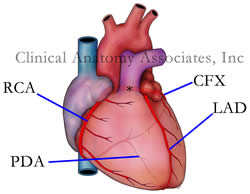|
The left coronary artery, sometimes called the [left main coronary artery] or LMCA, is a short artery that arises from the aortic root at the left posterior coronary sinus of Valsalva, usually below the sinotubular junction. Its length is on average 1.3 cm, although it can be shorter. The LMCA courses between the left atrial appendage and the posterior aspect of the pulmonary trunk. The LMCA provides blood supply to almost 69% of the heart, making it most important in coronary blood supply to the heart. This apparently goes against the concept of coronary dominance if the concept is not clearly understood. You could have a "right dominant heart" and still have the LMCA provide blood supply to more than 50% of the heart. The left coronary artery bifurcates giving origin to two branches: the circumflex artery (CFX) and the left anterior descending artery (LAD). Each one of these arteries gives origin to several named branches and you can click on the links to follow each one. |
 |
| The left coronary artery has several anatomical variations, including one where it does not exist and the CFX and LAD arise separately from the aorta. In another common variation (25-33%) the aorta trifurcates giving rise to a [ramus intermedius]
Sources: |
|
| Back to MTD Main Page | Subscribe to MTD |